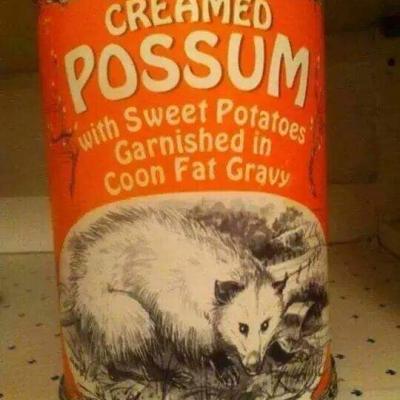The real lives of these homely misunderstood marsupials
- Tags:
- Wildlife

Opossums becoming more common but no less unusual in snowy NH. Photo Cody Pope Wikimedia Commons
The opossum came back… at least temporarily.
She was eating chicken feed when we went to close the hen house for the night. She cowered in the flashlight beam in the outer coop, unnerving the laying hens more intent on roosting just after sundown. With gentle persuasion (broomstick) and a clear path to escape, opossum scurried outside to the fenced enclosure, she scaled the orchard fence and disappeared into the night. Jailbreak!
I briefly contemplated a high speed pursuit and more lethal response. But research reveals opossums are benign- even beneficial. Opossums don’t eat chickens. In fact by eating snakes, mice, rats, insects and carrion, they provide helpful rodent control and sanitation on the farm. Opossums do eat eggs. We need to insure it can’t access the inner sanctum of laying boxes inside the hen house and collect eggs nightly when we close the fortress.
NH egg farmers combat seemingly hot and cold running predators. Eternal vigilance is the price of farm fresh breakfast. Opossum is a relatively new visitor. How she survives the same gauntlet of local predators including foxes, coyotes, fishers, bobcats and great horned owls I can’t imagine. Appearing to suddenly drop dead surely is a novel ploy!
“Playing possum” when threatened is an involuntary hard-wired neuromuscular response that’s more than a little disgusting. Opossums roll over with teeth exposed, drooling saliva and emitting a foul, putrid excretion from anal glands. Most smart predators are disinclined to further pursue them or consider them edible. One friend with Appalachian hillbilly roots insist that possums are delicious par-boiled, traditionally served over a bed of potatoes or peeled Sassafras twigs. “But we never had to eat one.”

Like election campaign staffers in NH, opossums are nocturnal except during food shortage. Make your own political analogies. They’re not territorial. They wander widely and do not maintain permanent dens or food caches. They have no home or kitchen. They crash locally by couch surfing, sharing quarters temporarily with a host of other local critters. They’ve reached an understanding with local porcupines. They coexist peacefully with raccoons and skunks. They cohabitate in dens simultaneously occupied by skunks, raccoons and woodchucks, none of whom are particularly fond of domestic dogs; they all share that in common.
Opossums don’t run, they shuffle. They are adroit tree-climbers. Our local opossum repeatedly climbs the chicken yard wire mesh fence to access the kitchen scraps tossed behind the hen house. Her tracks in the snow reveal a low slung creature without a tail drag mark. The opossums’ prehensile scaly naked tail adapted for grasping limbs and balance while climbing gives opossums a rat-like quality that wins few beauty contests.
‘Possum paw prints in snow appear star-shaped, clearly revealing five splayed toes including an opposable “thumb-like” inside toe on hind paws only. Only primates and humans have a similar opposable thumb designed for grasping.
Opossums are NOT social. They avoid contact with other opossums except during two brief mating seasons which peak from late January to March and again from late May to early July when females are receptive for no more than 36 hours during a 29 day estrous cycle. Good news: it’s ‘possum breeding time!
If all that were not odd enough, opossums are the only North American marsupials – related to koalas, wallabies and kangaroos. Females nurse and shelter offspring inside a fur-lined external pouch. After a gestation period of merely 13 days after mating, juvenile opossums the size of honeybees, spend the next sixty days nursing and growing inside the external pouch to emerge when about the size of mice in April
Opossums have become more numerous in NH. According to trapping data provided by Patrick Tate, NH Fish and Game furbearer biologist, incidental trapping of opossums documents an increase in their statewide abundance. In 2004 and 2005, a total of 20 opossums were taken by NH trappers. In the past decade that has grown to 140 in 2014 and 104 taken in 2015; a five-fold increase. Tate cites an opossums documented north of the White Mountains in Berlin.

First in Nation ‘Possum Prognostication?
Opossums are nearly as numerous and well-travelled as NH Presidential Primary staffers. We know that’s been good for business and our unique “Live, Freeze and Die” branding.
But there is an imminent threat looming over our “First in the Nation” status. The spectacle of Pennsylvania’s “Punxsutawny Phil” Groundhog Day circus threatens to hijack the national media spotlight away from our First in the Nation contest in just two days unless…
Unless we declare February 1 as “Opossum Day” in NH. We should propose legislation to ensure our first in the nation status! All we need to do is haul a hapless critter from its snug hidey-hole in midwinter and roll out some authentic ‘possum prognosticating for our collective amusement.
I can begin February 1 by trying to extract an opossum from beneath my chicken coop, front porch or garbage can tomorrow morning. The opossum could then forecast a few things…
“Blossom the Opossum” could forecast the arrival of spring – crocuses, tulips, daffodils and lilac flowering times? This might provide hope at exactly the halfway point of winter and build anticipation of impending springtime.
Or we could measure how much of the opossum’s naked ears and tail have already frozen to the point of injury. Based on freeze injuries thus far, we might forecast the impending arrival of warmer weather? How’s that for gothic Yankee ingenuity?
Smart opossums are already forecasting a mass exodus of political candidates from NH in exactly ten days. Our local opossum quipped that NH television ads will soon include once-familiar car and furniture store quality commercials again.
And with that, she keeled-over and began to drool.
